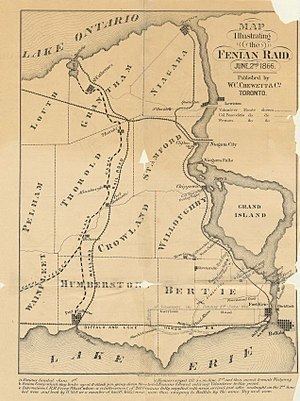400 (estimate) 79 | Date 2 June 1866 Location Fort Erie, Canada | |
 | ||
8–10 wounded59 captured 3-4 dead; 16 wounded54 captured Similar Fenian raids, Battle of Ridgeway, Siege of Fort Erie, Battle of Eccles Hill, Battle of Chippawa | ||
Battle of fort erie 1866
The Battle of Fort Erie was a bloody skirmish in the afternoon immediately following the Battle of Ridgeway on June 2, 1866 in Canada West. The Fenian force, withdrawing from Ridgeway towards the United States, met and defeated a small force of Canadian militia at Fort Erie, then known as the village of Waterloo.
Contents
In response to the Fenian occupation of the township of Fort Erie, Ontario on the night of June 1, 1866, militia units throughout the Niagara Peninsula had been mobilized or put on alert. At Port Colborne, a detachment of 51 gunners and N.C.O.s, British Royal Artillery bombardier Sergeant James McCracken and 3 officers (Captain Richard S. King M.D., Lieutenants A.K. Schofield and Charles Nimmo [Nemmo]) taken under command by Lieutenant-Colonel John Dennis, boarded a tugboat, the W.T. Robb carrying the Dunnville Naval Brigade, consisting of 19 men and 3 officers (Captain Lachlan McCallum, Lieutenant Walter T. Robb, Second Lieutenant Angus Macdonald) (a total of 71 men and 8 officers) and steamed east to the Niagara River, then scouted downriver as far as Black Creek. The Welland Field Battery did not have its four Armstrong guns with it, and only half were armed with Enfield muzzle-loading rifles, with the other half armed with obsolete smooth-bore "Victoria" carbines that had a limited range of approximately 300 yards at best.
The Fenians apparently gone, Dennis turned back upriver to secure the village of Fort Erie and deny them an easy escape route. Dennis and a company of the Welland Field Battery,landed without difficulty, rounding up a number of stragglers. But when John O'Neill returned with the bulk of his force from his victory at Ridgeway, the volunteers – expecting to encounter only scattered bands of defeated Fenians under close pursuit – were unable to resist them. A fierce firefight followed, in which the militia soldiers and sailors were swept off the shores by the better-armed Fenians and most of the Canadians who had landed were captured.
While his men were making their stand, Dennis ran away on foot and hid in a house, shedding his uniform and shaving off his luxurious sideburn whiskers. He would later be court-martialled for deserting his men but he was acquitted by two of the three officers serving on the tribunal. (George T. Denison, commanding officer of the Governor General's Horse Guard voted to convict on some of the counts.) Except for the verdict, the conduct of the Dennis Inquiry (unlike the one into the conduct of Colonel Booker at Ridgeway) was kept secret. The contents were not released even a year later to members of Canadian Parliament who were demanding to see the transcripts of the testimony. While the original transcripts are available to researchers today in the Canada Archives in Ottawa, their contents have never been published in print anywhere.
The remaining Canadians on the gunboat steamed back to Port Colborne, leaving O'Neill and the Fenians in possession of Fort Erie once more. However, with an estimated 5,000 British regulars and Canadian militia converging on his position, and a U.S. naval detachment blocking any attempts at reinforcement, that night O'Neill hastily planned his retreat back to New York State. Some Fenians chose to desert, crossing the river on a variety of stolen or improvised craft. The remainder, 850 in number, crossed in a body and surrendered to a U.S. naval party from the USS Michigan near Buffalo, putting an end to Fenian incursions along the Niagara Peninsula.
